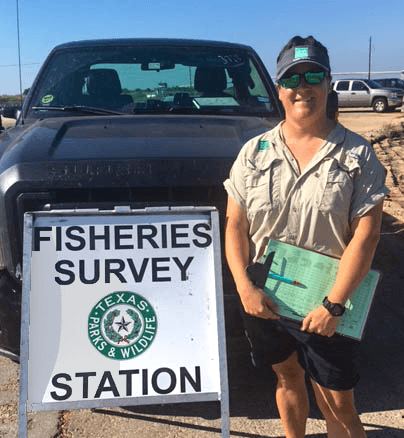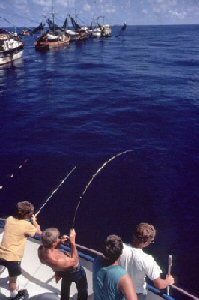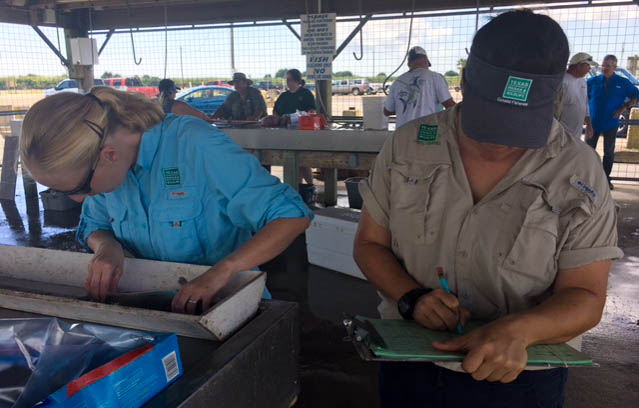Coastal Creel Surveys
by Lee M. Green, Texas Parks and Wildlife Department, Coastal Fisheries Division, Program Specialist, Rockport
Texas Parks and Wildlife Department is required to conduct scientific studies and investigations on all species of aquatic animal life in order to estimate their supply and to determine factors or conditions causing changes in their supply. Determining how many fish are being caught and kept by anglers is one of the primary ways Coastal Fisheries carries out this mandate.
We have determined that marine sport fishing decreases the supply of fish, so the level of fish harvest can serve as an indicator of fish availability. The amount of angling activity and harvest are estimated with data collected from anglers during coastal harvest surveys. These surveys are generally called creel survey because creel is a traditional term for the woven basket in which harvested fish are temporarily stored. The Department initiated creel surveys along the Texas coast in fall 1974 and adjusted survey methods until the current format was adopted in 1983.

Creel surveys are conducted throughout the year from 10 AM to 6 PM at specified boat-access sites along the entire Texas coast from Port Arthur to Port Isabel. Over 1,000 surveys are scheduled annually on randomly selected weekdays and weekend days. Boat-ramp and wet-slip sites are surveyed in proportion to the amount of fishing activity occurring at each: Busy sites get surveyed more often than idle ones. This design results in about 14,000 sportfishing interviews each year.
A typical trip-ending coastal creel interview includes questions relating to the fishing trip plus the interviewer examines and counts the catch as quickly as is practical. Six randomly selected fish of each species are measured for total length to the nearest millimeter. Angling parties are asked what time they begin their trips, what county each angler resides in, what bay or gulf area the retained fish were caught in, and what types of gear and bait were used to catch the retained fish. In addition, one randomly selected angler from each fishing party is asked about the species of fish sought and the level of satisfaction with the trip.

From the data collected, we can determine the amount of fishing effort expended, the number of fish landed, the number of fish landed per unit of fishing effort, the species composition of landed fish, and the size of landed fish. Trends in these statistics reflect the condition of the fishery.
Private-boat fishing effort and landings in Texas bays and passes have decreased from high levels in 1999. The greatest amount of private-boat fishing effort and landings occurs in the Galveston Bay system. Spotted seatrout is by far the species most often landed by private-boat anglers in Texas bays and passes. Spotted seatrout and red drum landed by private-boat anglers from Texas bays and passes averaged 17.2 and 23.5 inches, respectively, during the 2002-03 survey year (mid-May of one year to the next).

Department personnel spend many hours each year conducting creel surveys at coastal boat-access sites. During this time they endure a variety of hazards, encounter challenging circumstances, and observe unusual incidents.

Hazards have included: weather extremes; sun exposure; slick surfaces; and sharp spines, teeth, and gill covers. Challenging circumstances have included: getting in and out of docked boats and boats on trailers; enumerating stringers, buckets, ice chests, or wire baskets full of fish; measuring very large fish or fish that are cold, bent, and stiff; handling lively fish kept in a live well; enumerating filleted fish; identifying certain gulf fishes; dealing with impatient, uncooperative, disgruntled, or intoxicated anglers; informing anglers when their landings violate bag or size limits; keeping up with the flow of boats when an unexpected thunderstorm or cold front passage causes a simultaneous exodus of many boats; keeping data sheets relatively clean of fish slime and blood; and assisting anglers with a variety of problems. Unusual incidents have included: launching and haul-out difficulties; anglers slipping or falling into the water; and anglers returning with various injuries or hooks impaled in their bodies…. But these are another story.
© Copyright Texas Parks and Wildlife Department. No part of this work may be copied, reproduced, or translated in any form or medium without the prior written consent of Texas Parks Wildlife Department except where specifically noted. If you want to use these articles, see Site Policies.